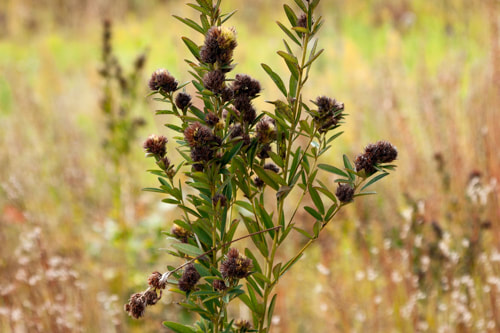Pea Family (Fabaceae)
Click a link below to find out more about each plant in the Pea Family:
|
How can I recognize a member of the pea family?
Look at their distinctive flower petals and fruits. Count the flower petals. There should be five. However, they are not all the same shape or size, and two petals are fused together. The fruits look like beans. At Nachusa we call the members of this family “legumes.” Most legume seeds split open along two seams — think of how peas and green beans open. |
Cool stuff to know about legumes
Legumes have a symbiotic relationship with bacteria. The bacteria that live on their roots change nitrogen into food the plant can “eat.” In return, the legumes provide the bacteria with energy in the form of carbohydrates. When the plant dies, the bacteria release the nitrogen into the soil to create food for nearby plants. |
Illinois ticktrefoilDesmodium illinoense
Hitchhiking allowed! This plant parent is happy for its kids (seeds) to hitch a ride with you! Humans and other mammals actually help the plant disperse its seeds. How? The seeds have tiny, hooked hairs that grab your clothes, your hair, or anything else they can attach to. No worries though, for the seeds easily peel off. Tastes good At Nachusa, wild turkeys, deer, wood chucks, rabbits, and white-footed mice may eat the leaves. Skippers, the Eastern tailed blue, and the gray hairstreak butterfly larva may also feed on this plant. Scientific name origin In Greek, desmos means to band, bind or chain. So, Desmodium refers to the ticktrefoil’s seed pod, formed from segments joined together. purple prairie cloverDalea purpurea
This plant sign is under construction. Check back next time. round-headed bush cloverLespedeza capitata
Wrong Name! Have you ever had your name misspelled? Lespedeza capitata was named for Vicente Manuel de Céspedes, the governor of the Spanish province of East Florida in the late 18th century, but the first time the plant's name was printed, it was misspelled as “de Lespedeza” and it stuck! Protein-rich At Nachusa, deer, rabbits, and muskrats enjoy eating this protein-rich plant. The seeds are especially tasty to mourning doves, bobwhites, wild turkeys, and juncos. Both long and short-tongued bees enjoy the nectar of the flowers and caterpillars of certain skipper butterflies like cloudywings, hoary edge, and silver-spotted eat the leaves. Scientific name origin In Latin, capitata means growing in a head. So, capitata refers to the plant's round cluster of white flowers with pink-red centers, that looks like a head. |
white prairie cloverDalea candida
This plant sign is under construction. Check back next time. white wild indigoBaptisia lactea
This plant sign is under construction. Check back next time. |



